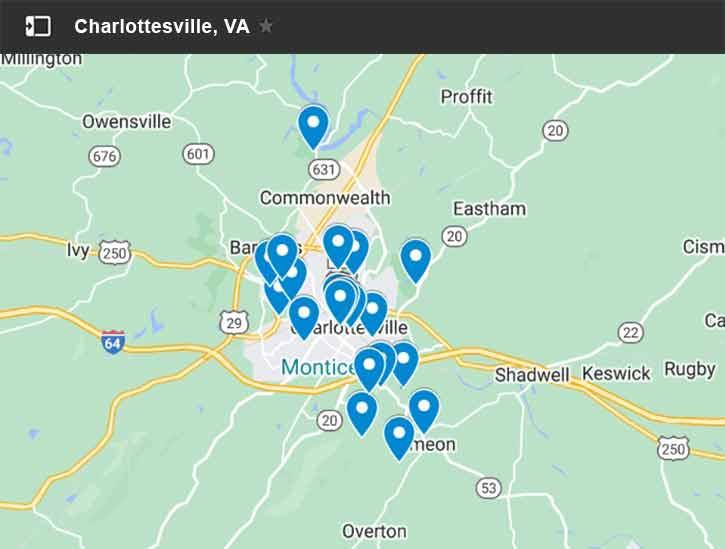Nestled along the beautiful Rivanna River just east of Virginia’s Shenandoah Valley, Charlottesville introduces travelers to the early history of the United States in a setting of abundant natural beauty. The UNESCO World Heritage sites of Monticello and the University of Virginia are steeped in history, with additional heritage sites within easy reach. Cultural activities also abound, and travelers can also find verdant green spaces to explore within the city and a few minutes’ drive away.
Interactive Map of 25 Things to Do in Charlottesville (VA)
1. Monticello
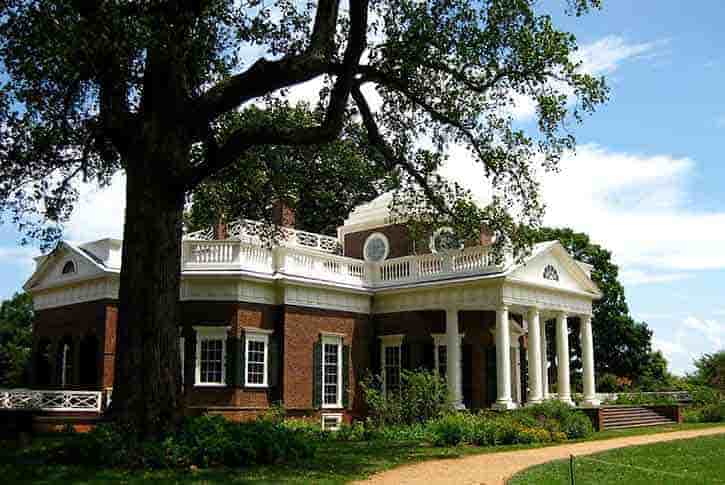
As the home of Thomas Jefferson, Monticellois the top destination for most visitors to Charlottesville. Designed by Jefferson, himself, the main house underwent decades of renovations as the nation’s third president incorporated European influences from his travels into the plantation home.
Aside from guided and self-led tours, this UNESCO World Heritage Site offers specialized activities on topics such as slavery at Monticello and a Gardens and Grounds tour. Staff recommend advance reservations, and tours of the house, itself occur on a schedule designated on each ticket. Visitors may wish to pay their respects at the African American burial ground and check out one of the many gardens on site.
2. University of Virginia
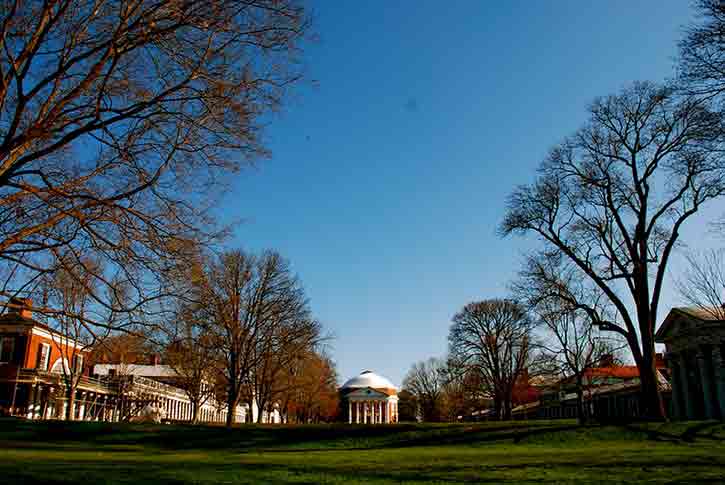
Founded by Thomas Jefferson in 1819, the University of Virginia campus welcomes visitors to explore its stunning grounds. Designated as a UNESCO World Heritage Site along with nearby Monticello in 1987, the university’s neoclassical Academical Village provide insight into Jefferson’s vision of the new American republic. Organized around the central Lawn with the landmark Rotunda library building at its heart, the campus blends elegantly into the surrounding landscape.
The university is in the process of constructing a memorial to the over 4,000 enslaved individuals who built and maintained the campus. Their labor enabled the implementation of Jefferson’s design and what many consider to be the most beautiful public university in the United States.
3. Virginia Discovery Museum

The Virginia Discovery Museum is Charlottesville’s best spot for younger children. Visitors should not be fooled by the small façade of the museum’s entrance. The facility is home to 6,000 square feet of adventurous learning. Kids can slide down from the upper floor of a fire station, try out life as a doctor in a mini Children’s hospital, or hang out in an eighteenth-century cabin.
Programs like Discovery Detectives combine art with storytelling and enable kids to solve a mystery while expressive their creativity. The nonprofit museum also houses a working kiddie carousel with painted aluminum horses originally cast in 1910.
4. Charlottesville Downtown Mall
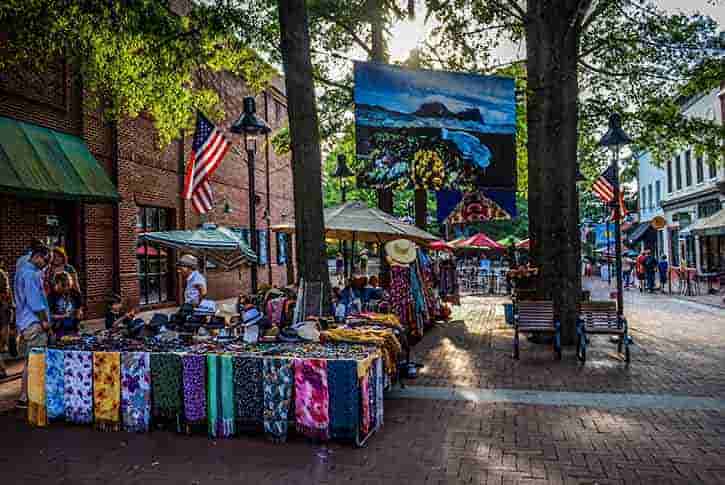
One of the best ways to soak up Charlottesville’s historic vibe is to stroll along the eight pedestrian-only blocks of the Downtown Mall. Visitors can literally walk in the footsteps of Thomas Jefferson, James Madison, and James Monroe as they shop, eat, drink, or take in a live show. More than thirty restaurants line the streets of the Mall, with half a dozen art galleries and over a hundred independent shops.
Perfect for a night out or a casual day downtown, the Mall is one of America’s most walkable downtowns. Free trolley service connects the Mall to the University of Virginia Campus.
5. James Monroe’s Highland
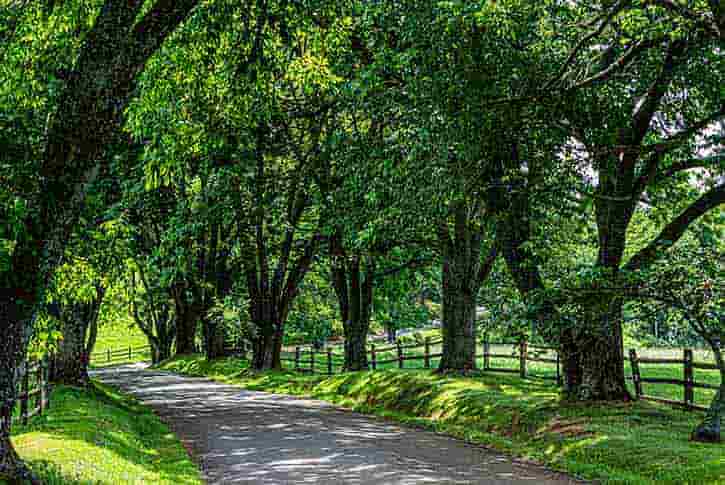
Often overshadowed by neighboring Monticello, James Monroe’s Highland estate makes a fascinating destination for travelers interested in exploring the home life of the nation’s first leaders. The site includes later additions to Monroe’s early nineteenth-century home, but still offers an in-depth look into Monroe’s life and times.
Inside the house visitors can peruse Monroe-family artifacts, including a sampler stitched by Monroe’s eleven-year-old daughter Maria Hester. Archaeological investigations at Highland are ongoing, with new information dug up each year. Highland also follows the estate’s history beyond Monroe’s life there, with exhibits on its enslaved inhabitants and recreated slave quarters.
6. Shenandoah National Park
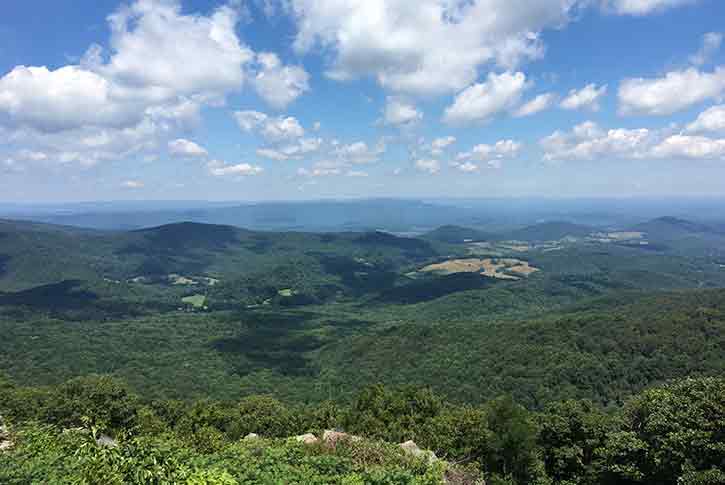
One of the most scenic drives in the United States can be found just half an hour west of downtown Charlottesville. The picturesque Shenandoah Valley runs northeast from the Charlottesville area to Front Royal, Virginia. Travelers can follow Skyline Drive through the Shenandoah National Park for outstanding views of the surrounding landscape.
Designated as a National Scenic Byway, the road runs along the crest of the Blue Ridge Mountains for 105 miles. Be sure to keep an eye out for wildlife. National Park Service Visitor Centers, hiking trails, restaurants, and scenic overlooks can be found along the way.
7. Jefferson Vineyards

Wine-lovers will appreciate an opportunity to visit the birthplace of American wine. In 1981 the Woodward family re-established Jefferson Vineyards on land selected almost 250 years ago by Thomas Jefferson’s Florentine friend, Philip Mazzei, for a wine-making venture. Shaded seating is available on the lovely grounds, where guests are invited to relax and soak in the views.
Visitors are invited to bring a picnic meal to enjoy onsite, where they can learn more about those early days of Jefferson and Mazzei. Private tastings permit guests to sample the award-winning modern vintages currently produced at the vineyards.
8. The Fralin Museum of Art
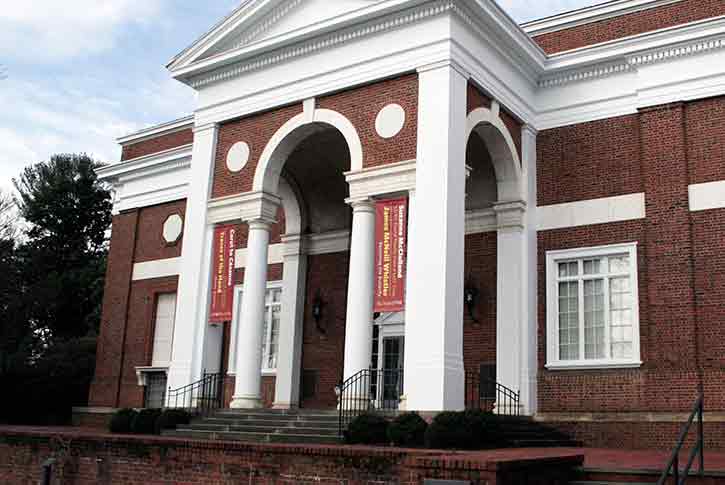
Hidden treasures may be found at the Fralin Museum of Art. Situated on the University of Virginia Campus two blocks north of the Rotunda and offering free admission, the museum makes for an excellent outing. Its 14,000-piece collection holds an impressive range of works from European and American masters such as Rodin, Mary Cassatt, John Singer Sargent, and Georgia O’Keefe.
Other strengths of the collection include African and American Indian art. Temporary exhibitions are of high quality, and often offer atypical genres, such as aboriginal Australian memorial poles or photographic images of the ruins at Pompeii.
9. Albemarle Charlottesville Historical Society
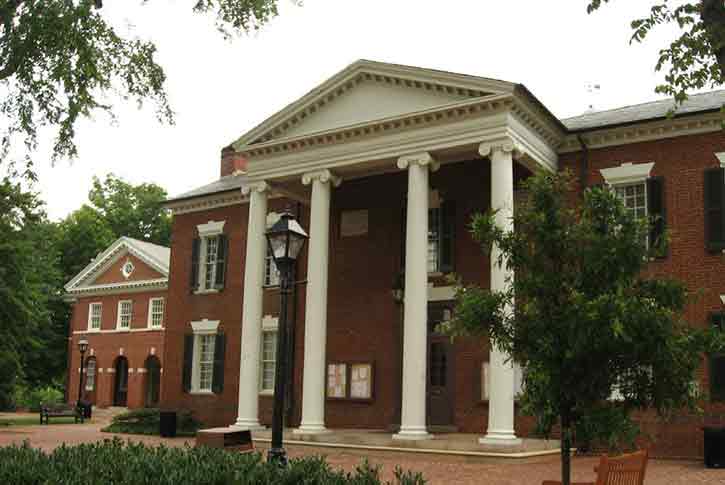
Lovers of history should head one block north from the heart of Charlottesville’s Downtown Mall to Market Street Park, where they will find the Albemarle Charlottesville Historical Society. Established in 1940 to preserve local history, the society offers a wealth of historical services.
The society hosts lectures on local history and provides workshops on how to research family history. Members arrange walking tours of the city and make archival documents available to researchers. Over 3,000 historical artifacts are contained in the collection, along with more than 6,000 documents, maps, and photographs.
10. Michie Tavern
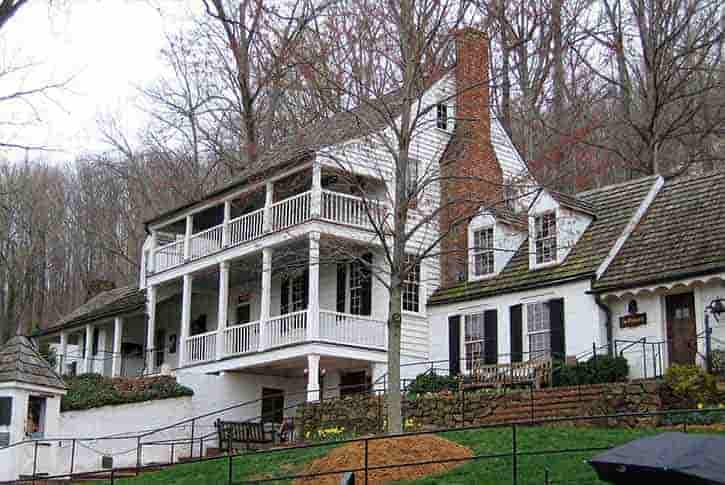
Michie Tavern’s unique dining experience enables patrons to travel back in time to the eighteenth century. Set in the same historic building once operated by the Michie family for generations, wait staff in period costume serve up traditional Southern food in an immersive sensory experience. Visitors can imagine themselves in the tavern two hundred years ago, warmed by the hearth as they appreciate the rustic period décor.
For those travelers who visit Charlottesville for its history, Michie Tavern is the ideal culinary accompaniment to a day of sightseeing. First established in 1784, the tavern moved to its current location in the early twentieth century.
11. Carter Mountain Orchard and Country Store Riverview Park

For stunning views of the countryside south of Charlottesville, head out to Carter Mountain Orchard and Country Store. Set on a hillside near Monticello and Michie Tavern, with sprawling rows of fruit trees and vegetable gardens, Carter Mountain offers more than just the views.
Each season from April through December visitors can drop by to pick their own produce or purchase a fresh-baked apple pie at the bakery. The orchard is also home to a country store, ice cream parlor, and winery. Visitors highlight the lovely landscape and recommend the apple cider donuts.
12. McGuffey Art Center
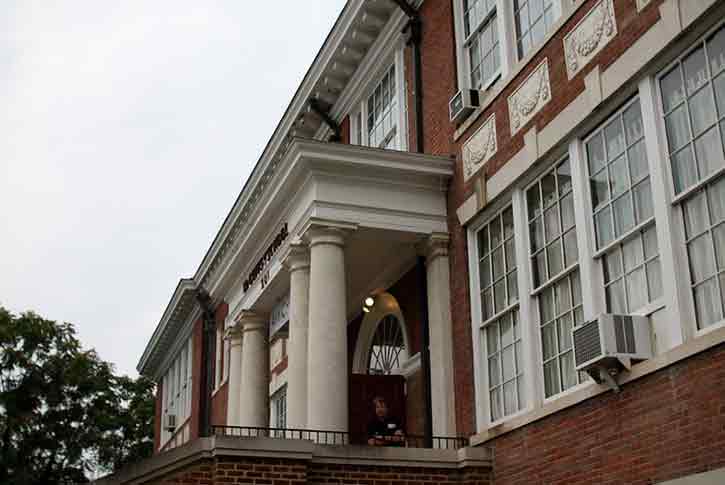
As one of the oldest art-run co-ops in the United States, McGuffey Art Center is home to dozens of artists working in a variety of media. The first Friday of each month is the best time to visit, as the artists open their studio spaces to the public. On other days they display their work in the on-site galleries.
McGuffey artists offer classes and free tours to students, run summer camps, and organize workshops for community members and visitors to try their hand in a creative endeavor. Event planners can secure flexible space at the center for group activities.
13. Forest Hills Park
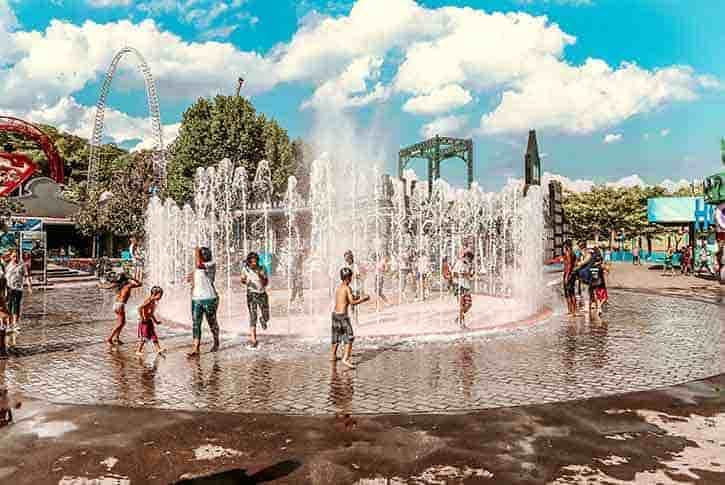
Set among oak trees on the south side of Charlottesville, Forest Hills Park offers a chance for outdoor recreation for all ages. The park’s location in the city makes it easy to access. Kids will enjoy the spray ground water park and playground, which includes a rare merry-go-round. Athletes can take advantage of the two full basketball courts and baseball field.
Forest Hills Park’s 7.35 acres provide plenty of good locations for a picnic, with two pavilions and various individual picnic tables. The nearby trees provide leafy shade and help enhance the feel of stepping back from the surrounding city.
14. The Glass Palette
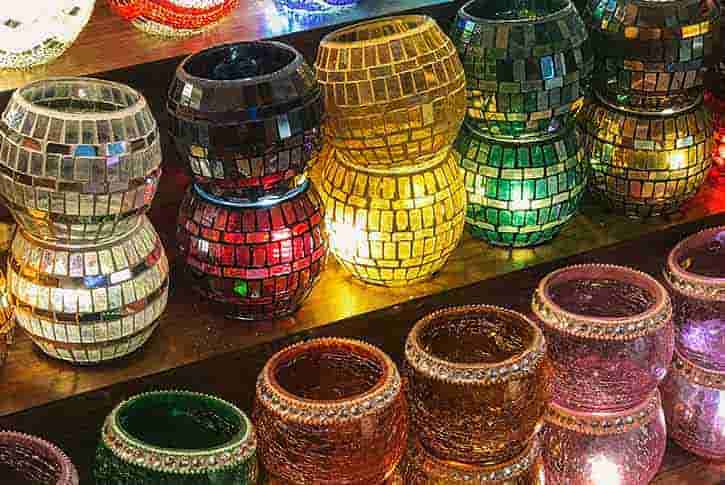
Feeling inspired? Check out The Glass Palette, where you can create your own glass art. Walk ins are welcome, and no experience, tools or materials are required. Co-owners Maria and Cara DiMassimo are on hand to teach you the basics of glass art and enable you to create your own masterpiece.
Multiple forms of glass work are on offer, from fusing in a kiln to bead-making, stained glass, and sandblasting. Visitors can design their own jewelry, lamps, dishes, and other works of art. You can make a reservation to be sure your preferred time is available, or just order a glass kit to go that you can work on at home.
15. McIntire Park
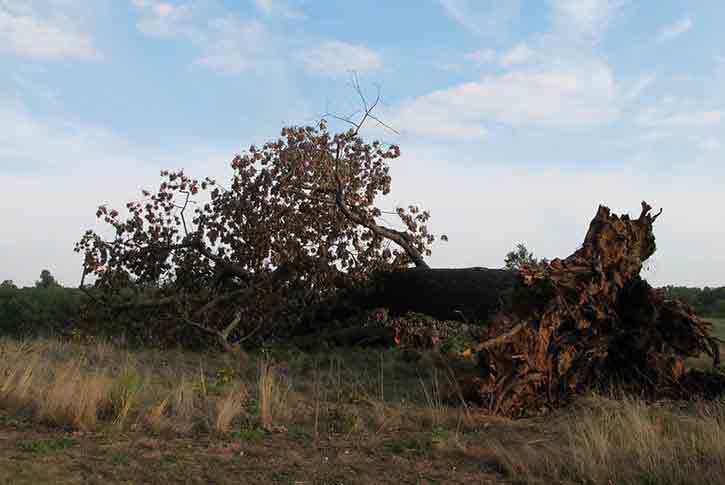
On the northeastern edge of Charlottesville, expansive McIntire Park is the largest in town. Whether you are looking for hiking, picnics, or sports, this park has it all. With three shelters, baseball and softball fields, playgrounds, and plentiful walking trails, the park sees regular use year-round. Each April the city’s Annual Dogwood Festival is held here.
McIntire is also home to the Charlottesville Skateboard Park, with concrete pools, ramps, and rails for beginners and experts. The Dogwood Vietnam Memorial can be found at the south end of the park. The park formerly contained a nine-hole golf course that has since been closed to make room for the planned McIntire Botanical Garden.
16. Immersion Escape Rooms
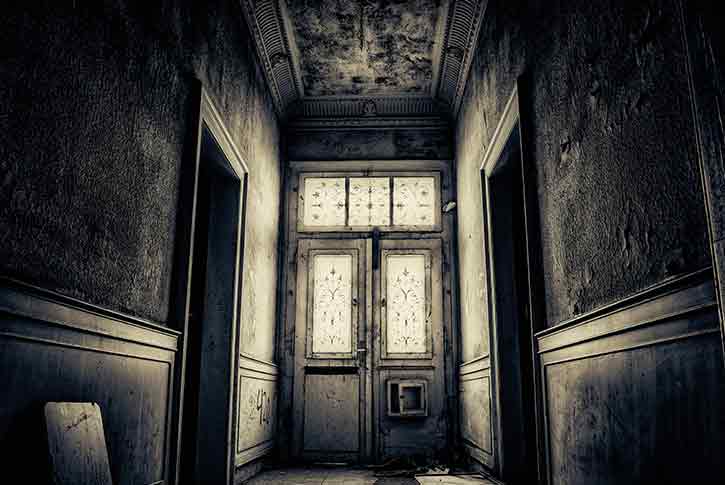
Have you ever wanted to jump into a suspenseful film or TV show to become the protagonist in an exciting mystery? Located just to the north of the University of Virginia campus, Immersion Escape Rooms endeavors to offer such an experience in Charlottesville. Their detailed approach provides a film-like environment that includes props and hidden puzzles, drawing visitors into well-developed characters.
Immersion invites groups to step into the story and work their way out together. Immersion experiences generally take around one hour to complete. Race against the clock to see if your group can solve the mystery in time. Online reservations are required.
17. Greenleaf Park
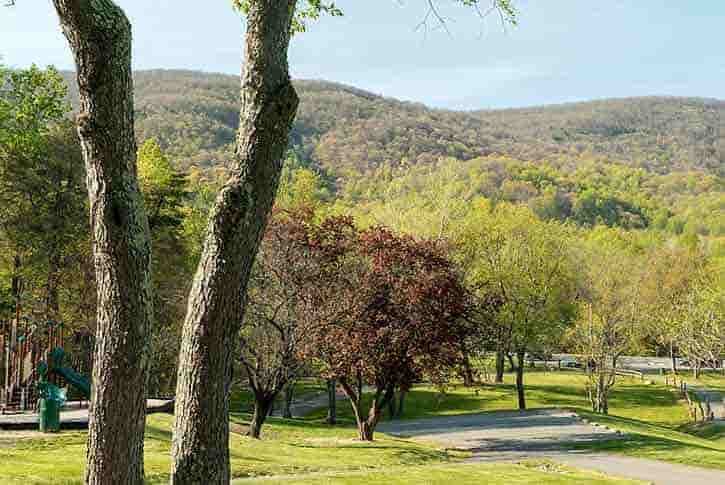
Set along 14 acres of leafy hillside on the north side of town, Greenleaf Park is one of Charlottesville’s many accessible outdoor spaces. Playgrounds and climbing equipment will please the younger kids, as will the spray ground complete with a mushroom fountain and touch sensitive features. Go for a walk along the creek or join a game on the basketball court.
Greenleaf also has a pavilion and a charcoal grill available. No reservation is necessary. The public Crow Recreation Center, with an indoor pool, billiards, and air hockey, is situated just next to the park.
18. John Paul Jones Arena
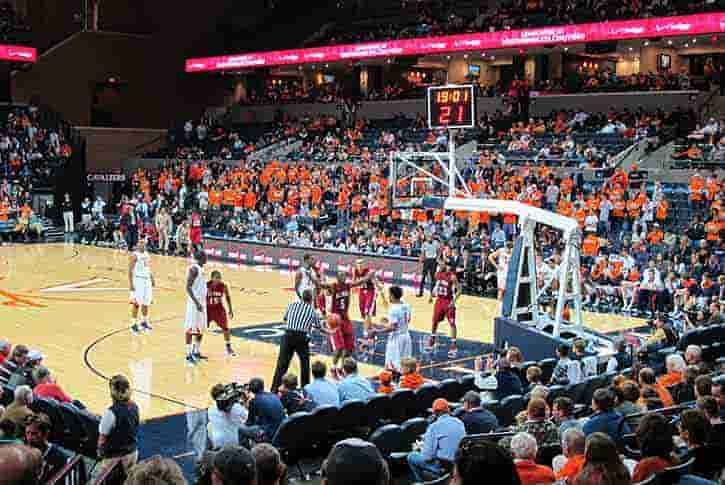
Completed in 2006, John Paul Jones Arena is the home court for the University of Virginia basketball program. The indoor arena is the largest in Virginia, and the largest Atlantic Coast Conference arena outside of a large city. Architecturally, the arena employs Roman pergolas to resonate with the University of Virginia’s neoclassical style.
The nearly 15,000-seat venue also hosts major entertainment events in the Charlottesville area, ranging from Lady Gaga to the WWE. Located on the north side of the UVA campus, the arena is easily accessible and close to ample visitor parking.
19. Saunders-Monticello Trail
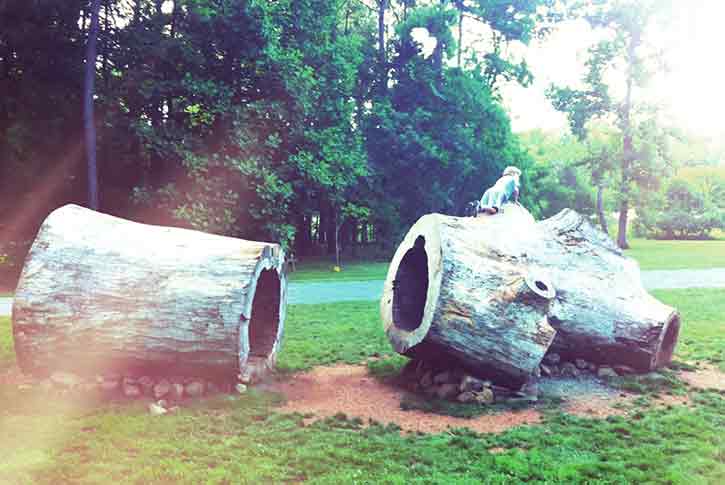
Winding alongside the picturesque Thomas Jefferson Parkway from the south side of Charlottesville to Monticello, the Saunders-Monticello Trail offers bicyclists and pedestrians an alternate route to make the journey to Monticello.
Two miles each way, the trail heads through Kemper Park before slowly climbing the side of Carter mountain. There travelers are treated to excellent vistas of the Blue Ridge Mountains. With less than a 5% grade for its entire length, the trail is accessible for wheelchair users. The trail is a destination unto itself, whether you are planning later activities at Monticello or just looking for some refreshing outdoor exercise.
20. Jefferson Theater
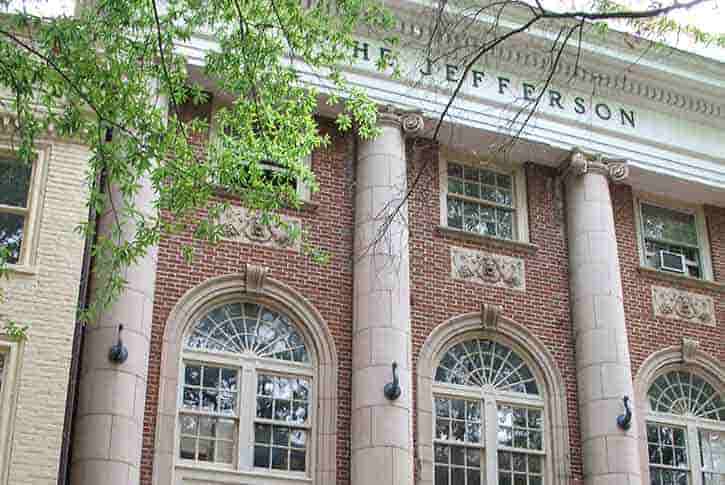
Originally built in 1912 to serve as a vaudeville house and cinema, the Jefferson Theater played host to legendary performances by acts such as the Three Stooges and Harry Houdini. From the 1970s through the end of the twentieth century the venue offered discount films to the Charlottesville community.
The proscenium-style theater completed a major restoration in 2009, reopening as Charlottesville swankiest spot for live music. With two full-service bars and an upper balcony rentable as an exclusive group space, the Jefferson continues to host special events and high-quality musical acts.
21. Sprint Pavilion
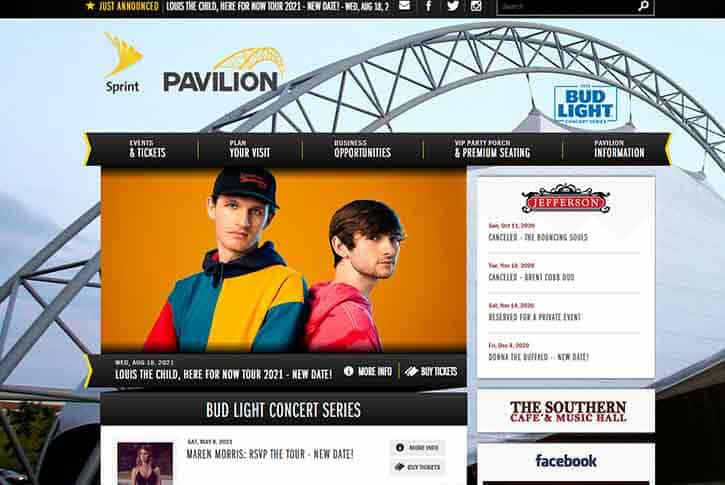
On the east end of Charlottesville’s Downtown Mall, Sprint Pavilion plays host to outdoor concerts under a massive white canopy. Its Fridays After Five summer tradition offers visitors and community members the opportunity to enjoy local music for free.
Those looking to obtain a prime seat for a small group can reserve a premium box complete with reserved parking and wait staff. For larger crowds, the VIP Party Porch can hold up to 50 people on the side lawn, with access to a private bar looking out over the stage. With close access to the rest of the city, it is easy to integrate a night out at Sprint Pavilion during your time in Charlottesville.
22. The Paramount Theater
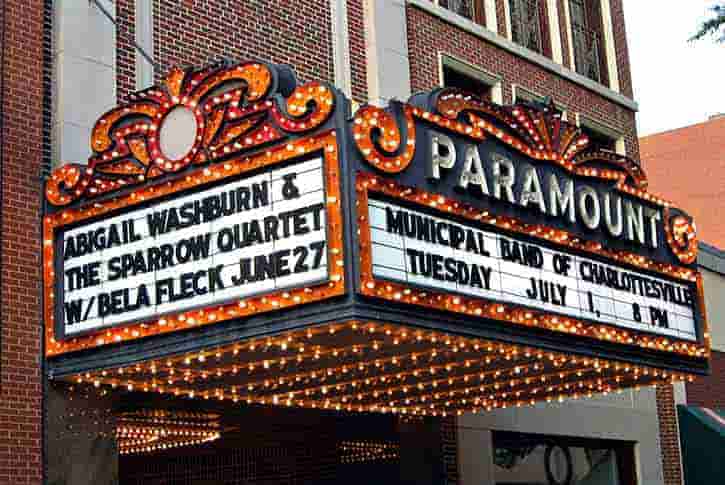
From its 1931 opening through 1964, the Paramount Theater served as a segregated movie palace. After the Civil Rights Act opened public spaces up to all people, the Paramount continued showing films for another decade before closing its doors for almost two decades. A non-profit organization gave the space a new life in the early 1990s, re-envisioning the theater as a venue for both live and screen performances.
Now home to performing arts of all sorts, the theater is once more a magnet for community members and visitors interested in cultural entertainment. Its neoclassical façade is in keeping with Charlottesville’s historic architectural vibe.
23. The Southern Café & Music Hall

In the center of the Downtown Mall, the Southern Café and Music Hall provides a one-stop location for comfort food and good tunes. As you might expect, the café side of the business serves up traditional Southern food. Available to both concertgoers and walk-ins, the kitchen is always cooking before and during performances.
The 300-seat Music Hall brings in around 150 regional and national artists each year and is a favorite of UVA students. Comedy acts also frequent the site. The Southern also hosts weddings, parties, and business meetings. Travelers enjoy the quality food and intimate feel of the space.
24. Ivy Creek Natural Area

From the family farm of a former slave to a 219-acre nature reserve, the story of Ivy Creek Natural Area is preserved alongside the land at this lovely site Situated six miles north of Charlottesville along the Rivanna River Reservoir, Ivy Creek is home to a wide array of wildlife, including white-tailed deer, numerous songbirds, and even black bear.
Hikers can explore the eleven trails on site, but measures in place to protect the local fauna prohibit dogs, hunting, or camping. This approach creates a serene peacefulness that distinguishes Ivy Creek from many other natural areas.
25. Lewis & Clark Exploratory Center
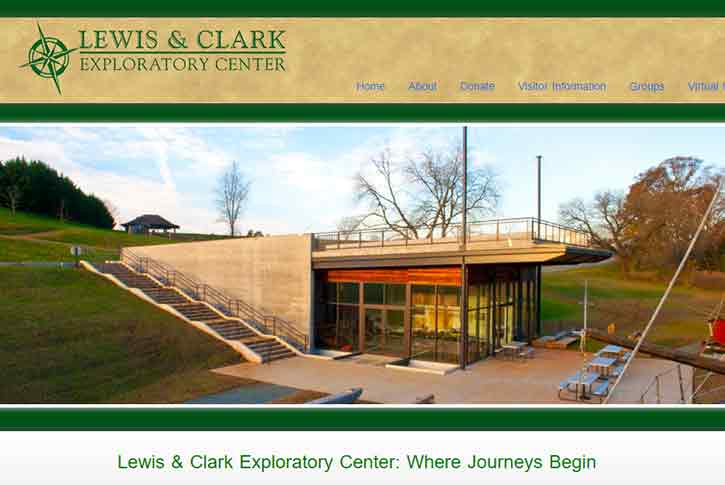
If you have every imagined what it might have been like to take part in the legendary Lewis and Clark Expedition through the American west, Charlottesville can take you to the next level.
Located in Darden Towe Park on the east side of the city, the Lewis & Clark Exploratory Center welcomes visitors with tours of full-sized replica boats from the expedition, and hands on activities such as mapmaking, carpentry, and drawing. The site is on land formerly owned by William Clark’s family, along the Rivanna River about thirty minutes upstream from Monticello.


